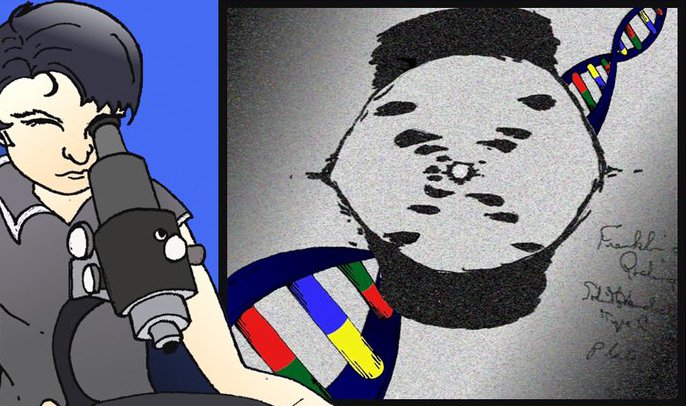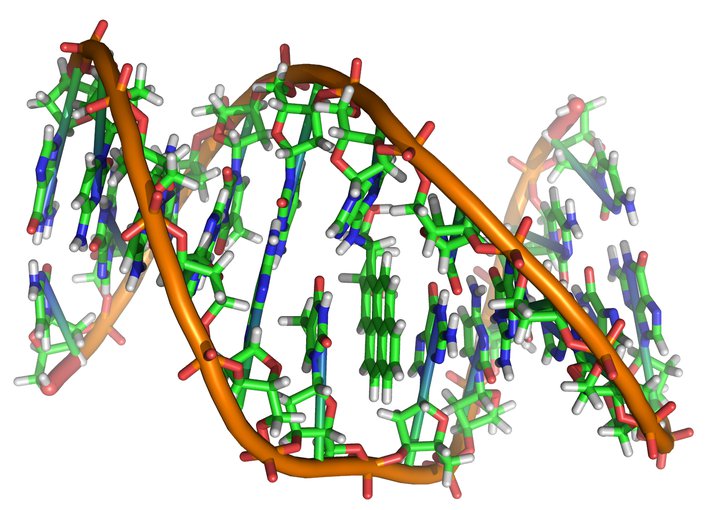
April 25th marks National DNA Day, which commemorates the discovery of DNA’s double helix structure in 1953 and the completion of the Human Genome Project in 2003. The 108th Congress of the United States (2003-2005) passed resolutions designating the 25th of April as DNA Day with the goal to “offer students, teachers and the public an opportunity to learn about and celebrate the latest advances in genomic research and explore how those advances might impact their lives” (1).
Deoxyribonucleic acid, or DNA, is the chemical molecule used by life on Earth to store genetic information. DNA is made of the nucleic acids adenine, thymine, guanine, and cytosine, often represented by a string of letters (ATGC). This is the ‘alphabet’ in which genes are written, the instructions from which proteins in cells are made. Basically, DNA is like a blueprint that all the mechanisms in your cells use when building the molecules you need to survive.

British Scientist Rosalind Franklin performed research in x-ray diffraction that provided our understanding of DNA. This was a seminal step in our understanding of life, and her incredible work has had a profound influence on the science of astrobiology. Franklin features in Issue 1 of the Astrobiology Graphic Histories: https://astrobiology.nasa.gov/resources/graphic-histories/Image credit: NASA Astrobiology/ Aaron Gronstal.
DNA in the Study of Life
DNA is central in many areas of astrobiology research because it carries the blueprint for life as we know it. When astrobiologists gather samples of microbes from extreme environments, they often extract DNA from the samples to understand the organisms that live there. The DNA can tell scientists who the organisms are and what role they play in both the community and the broader ecosystem. DNA can tell us many things about an organism, such as what it eats or whether or not it can live in extreme heat or cold.

Scientist Rosalind Franklin, the namesake of the European Space Agency’s future Mars rover, played a key role in the discovery of DNA’s double helix structure. This image is from Issue 2 of the Astrobiology Graphic History, available at: https://astrobiology.nasa.gov/resources/graphic-histories/Image credit: NASA Astrobiology/ Aaron Gronstal.
DNA also tells us how different organisms are related to one another. Because of this, astrobiologists can use DNA to trace the history of life on Earth. By comparing DNA from different organisms across the tree of life, we can see how DNA molecules have evolved and changed over time. Scientists have identified many genes in DNA that are shared across all organisms on the branches of the tree of life. This is why we believe that all life on Earth today might trace back to what is called the ‘Last Universal Common Ancestor’ or LUCA.
DNA has been essential in understanding the ‘Tree of Life’, helping astrobiologists map the relationships between all the different types of organisms on Earth and to trace the evolution of genetic material. Issue 7 of the Astrobiology Graphic History is available at: https://astrobiology.nasa.gov/resources/graphic-histories/Image credit: NASA Astrobiology/ Aaron Gronstal.
DNA in Life’s Origins
Astrobiologists don’t yet know when DNA first appeared on Earth. The origin of DNA on Earth might be tied to the origin of life. It is also possible that the earliest life could have existed without DNA by using some other molecule to store information. Today, some astrobiologists are trying to build DNA from scratch, or build DNA that isn’t found in nature, just to understand the basic ways in which it works. Research on the basic function of DNA has provided important insights for fields outside of astrobiology, and has even played a role in helping to fight the coronavirus.

Artist illustration of the chemical Structure of DNA.Image credit: Madeleine Price Ball/Creative Commons.
DNA in Biosignatures
DNA’s central role in life on Earth also means that it could be an essential molecule for biology that might exist beyond our planet. Astrobiologists have long studied DNA as a potential biosignature. If we landed a probe on an alien world and found DNA, we would know that life was present (as long as we followed planetary protection procedures to be sure we didn’t bring the DNA with us).
However, as a biosignature, DNA can mostly tell us about extant life, or life that is present in an environment ‘right now.’ In the example above, when an astrobiologist takes a sample from an extreme environment, the DNA tells them what organisms are currently living in the environment. When cells die and DNA is released, it is quickly eaten by other organisms or can be broken down by things like heat, chemistry, or radiation. This means that DNA isn’t an ideal biosignature for ancient life, because it usually doesn’t last for long periods of time (except in some special circumstances, like if cells are frozen in ice underground).

Artist illustration of DNA.Image credit: Richard Wheeler (2007)/Creative Commons.
These are just a few of the ways in which astrobiologists work with DNA to understand the origin of life on Earth and the potential for life in the Universe. Check out some more stories on astrobiolgy.nasa.gov that talk about how DNA is involved in astrobiology research at NASA!
RNA and DNA May Have Shared Building Blocks and May Have Appeared at the Same Time
NASA-Funded Research Creates DNA-like Molecule to Aid Search for Alien Life
Astrobiologists Aid in Fighting Coronavirus
Life’s Origins in a Mixed-Up World
Exploring Early Earth by Using DNA As A Fossil
Click here for a selection of scientific papers on DNA research supported by the NASA Astrobiology Program
Additional Resources:
(1) About DNA Day (National Institute of Health: National Human Genome Research Institute)

